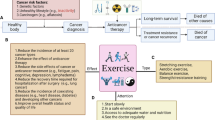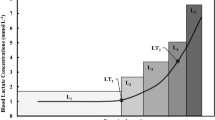Abstract
Purpose
Perioperative exercise could improve health outcomes of surgical lung cancer patients, but less is known about their natural physical activity (PA) behavior before exercise interventions. This review aimed to synthesize evidence on PA, regarding the following: (1) proportion of patients meeting PA guidelines, (2) amount of PA, (3) PA trajectory following surgery, and (4) correlates of PA before or after surgery.
Methods
We conducted a systematic review using PubMed, CINHAL, Scopus, and SPORTDiscus (July 2021). Observational or experimental studies that measure PA of lung cancer patients before/after surgery were included. We assessed methodological quality using the NIH Quality Assessment Tools and extracted data using a standardized form.
Results
Seventeen studies (25 articles, N = 1737 participants) published between 2009 and 2021 were included. Fourteen studies had sample sizes less than 100. Thirteen studies were of fair quality and four studies were of good quality. Only 23–28% of patients met PA guideline (150 min/week moderate-vigorous PA) at 6 months–6 years after surgery. Patients took an average of 3822–10,603 daily steps before surgery and 3934–8863 steps at 1–3 months after surgery. Physical activity was lower at 1 day–3 months after surgery, compared with preoperative levels. Perioperative PA was positively associated with exercise capacity, quality of life and reduced postoperative complications.
Conclusion
This review suggests that PA is low among surgical lung cancer patients, and it may not recover within 3 months following surgery. Physical activity has the potential to improve postoperative outcomes. However, the existing evidence is weak, and future larger longitudinal studies are needed.




Similar content being viewed by others
Data availability
Not applicable.
Code availability
Not applicable.
References
Fuller JT et al (2018) Therapeutic effects of aerobic and resistance exercises for cancer survivors: a systematic review of meta-analyses of clinical trials. Br J Sports Med 52(20):1311
Friedenreich CM et al (2020) Physical activity and mortality in cancer survivors: a systematic review and meta-analysis. JNCI Cancer Spectr 4(1):pkz080
McTiernan A et al (2019) Physical activity in cancer prevention and survival: a systematic review. Med Sci Sports Exerc 51(6):1252–1261
Caspersen CJ, Powell KE, Christenson GM (1985) Physical activity, exercise, and physical fitness: definitions and distinctions for health-related research. Health Public Rep 100(2):126–131
Rock CL et al (2012) Nutrition and physical activity guidelines for cancer survivors. CA Cancer J Clin 62:242–274
World Health Organization (2021) Cancer. Available from: https://www.who.int/news-room/fact-sheets/detail/cancer. Accessed 11 Oct 2021
Kneuertz PJ et al (2020) Long-term oncologic outcomes after robotic lobectomy for early-stage non-small-cell lung cancer versus video-assisted thoracoscopic and open thoracotomy approach. Clin Lung Cancer 21(3):214-224 e2
Cavalheri V et al (2019) Exercise training undertaken by people within 12 months of lung resection for non-small cell lung cancer. Cochrane Database Syst Rev 6:Cd009955
Cavalheri V, Granger C (2017) Preoperative exercise training for patients with non-small cell lung cancer. Cochrane Database Syst Rev 6:Cd012020
Cavalheri V et al (2013) Exercise training for people following lung resection for non-small cell lung cancer - a Cochrane systematic review. Cancer Treat Rev
Cavalheri V et al (2013) Exercise training undertaken by people within 12 months of lung resection for non-small cell lung cancer. Cochrane Database Syst Rev 7:Cd009955
Mainini C et al (2016) Perioperative physical exercise interventions for patients undergoing lung cancer surgery: What is the evidence? SAGE Open Med 4
Ni H-J et al (2017) Exercise training for patients pre- and postsurgically treated for non-small cell lung cancer: a systematic review and meta-analysis. Integr Cancer Ther 16(1):63–73
Pouwels S et al (2015) Preoperative exercise therapy in lung surgery patients: a systematic review. Respir Med 109(12):1495–1504
Rodriguez-Larrad A et al (2014) Perioperative physiotherapy in patients undergoing lung cancer resection. Interact Cardiovasc Thorac Surg 19(2):269–281
Rosero ID et al (2019) Systematic review and meta-analysis of randomized, controlled trials on preoperative physical exercise interventions in patients with non-small-cell lung cancer. Cancers 11(7):944
Sommer MS et al (2018) Effect of postsurgical rehabilitation programmes in patients operated for lung cancer: a systematic review and meta-analysis. J Rehabil Med 50(3):236–245
Zhou W, Woo S, Larson JL (2020) Effects of perioperative exercise interventions on lung cancer patients: an overview of systematic reviews. J Clin Nurs 29(23–24):4482–4504
Edbrooke L, Granger CL, Denehy L (2020) Physical activity for people with lung cancer. AJGP 49(4):175–181
Granger CL et al (2017) Understanding factors influencing physical activity and exercise in lung cancer: a systematic review. Support Care Cancer 25(3):983–999
Siddaway AP, Wood AM, Hedges LV (2019) How to do a systematic review: a best practice guide for conducting and reporting narrative reviews, meta-analyses, and meta-syntheses. Annu Rev Psychol 70(1):747–770
Moher D et al (2009) Preferred reporting items for systematic reviews and meta-analyses: the PRISMA statement. PLoS Med 6(7):e1000097
NIH. Study Quality Assessment Tools. Available from: https://www.nhlbi.nih.gov/health-topics/study-quality-assessment-tools. Accessed 10 Jan 2021
Arbane G et al (2014) Effect of postoperative physical training on activity after curative surgery for non-small cell lung cancer: a multicentre randomised controlled trial. Physiotherapy 100(2):100–107
Brocki BC, Andreasen JJ, Westerdahl E (2018) Inspiratory muscle training in high-risk patients following lung resection may prevent a postoperative decline in physical activity level. Integr Cancer Ther 17(4):1095–1102
Cavalheri V et al (2017) Exercise training for people following curative intent treatment for non-small cell lung cancer: a randomized controlled trial. Braz J Phys Ther 21(1):58–68
Cavalheri V et al (2016) Patterns of sedentary behaviour and physical activity in people following curative intent treatment for non-small cell lung cancer. Chron Respir Dis 13(1):82–85
Coups EJ et al (2009) Physical activity among lung cancer survivors: changes across the cancer trajectory and associations with quality of life. Cancer Epidemiol Biomarkers Prev 18(2):664–672
Coups EJ et al (2009) Correlates of physical activity among lung cancer survivors. Psychooncology 18(4):395–404
Esteban PA et al (2017) Evaluating patients’ walking capacity during hospitalization for lung cancer resection. Interact Cardiovasc Thorac Surg 25(2):268–271
Jonsson M et al (2019) In-hospital physiotherapy and physical recovery 3 months after lung cancer surgery: a randomized controlled trial. Integr Cancer Ther 18:1–9
Jonsson M et al (2019) In-hospital physiotherapy improves physical activity level after lung cancer surgery: a randomized controlled trial. Physiotherapy 105(4):434–441
Kong S et al (2020) Seasonal variation in physical activity among preoperative patients with lung cancer determined using a wearable device. J Clin Med 9(2):349
Krebs P et al (2012) Health behaviors of early-stage non-small cell lung cancer survivors. J Cancer Surviv 6(1):37–44
Maeda K et al (2016) Effect of a postoperative outpatient pulmonary rehabilitation program on physical activity in patients who underwent pulmonary resection for lung cancer. Geriatr Gerontol Int 16(5):550–555
Novoa N et al (2009) Influence of major pulmonary resection on postoperative daily ambulatory activity of the patients. Interact Cardiovasc Thorac Surg 9(6):934–938
Novoa NM et al (2011) Value of the average basal daily walked distance measured using a pedometer to predict maximum oxygen consumption per minute in patients undergoing lung resection. Eur J Cardiothorac Surg 39(5):756–762
Timmerman JGJ et al (2018) Physical behavior and associations with health outcomes in operable NSCLC patients: a prospective study. Lung Cancer 119:91–98
Vargas Fajardo Mdel C et al (2014) An alternative method for predicting the risk of postoperative complications in lung resection. Arch Bronconeumol 50(3):87–92
Xianping H, Weihe Z, Yuefeng Z (2015) Features of fatigue in patients with early-stage non-small cell lung cancer. J Res Med Sci 20(3):266–272
Hung R et al (2011) Fatigue and functional impairment in early-stage non-small cell lung cancer survivors. J Pain Symptom Manage 41(2):426–435
Licker M et al (2017) Short-term preoperative high-intensity interval training in patients awaiting lung cancer surgery: a randomized controlled trial. J Thorac Oncol 12(2):323–333
Philip EJ et al (2014) Physical activity preferences of early-stage lung cancer survivors. Support Care Cancer 22(2):495–502
Feinstein MB et al (2010) Current dyspnea among long-term survivors of early-stage non-small cell lung cancer. J Thorac Oncol 5(8):1221–1226
Granger CL et al (2016) Deterioration in physical activity and function differs according to treatment type in non-small cell lung cancer - future directions for physiotherapy management. Physiotherapy 102(3):256–263
Kong S et al (2020) Association between sarcopenia and physical function among preoperative lung cancer patients. J Pers Med 10(4):166
Barği G et al (2021) Exercise capacity, muscle strength, dyspnea, physical activity, and quality of life in preoperative patients with lung cancer. Turk J Med Sci
Billé A et al (2021) Preoperative physical activity predicts surgical outcomes following lung cancer resection. Integr Cancer Ther 20:1534735420975853
Godin G, Shephard R (1985) A simple method to assess exercise behavior in the community. Can J Appl Sport Sci 10(3):141–146
Craig CL et al (2003) International physical activity questionnaire: 12-country reliability and validity. Med Sci Sports Exerc 35(8):1381–1395
Washburn RA et al (1993) The Physical Activity Scale for the Elderly (PASE): development and evaluation. J Clin Epidemiol 46(2):153–162
Andersen LG et al (2010) Construct validity of a revised Physical Activity Scale and testing by cognitive interviewing. Scand J Public Health 38(7):707–714
Keadle SK et al (2016) Prevalence and trends in physical activity among older adults in the United States: a comparison across three national surveys. Prev Med 89:37–43
Troeschel AN et al (2018) Physical Activity in cancer survivors during “re-entry” following cancer treatment. Prev Chronic Dis 15:E65
Forbes CC et al (2014) A comparison of physical activity correlates across breast, prostate and colorectal cancer survivors in Nova Scotia, Canada. Support Care Cancer 22(4):891–903
Blanchard CM et al (2008) Cancer survivors’ adherence to lifestyle behavior recommendations and associations with health-related quality of life: results from the American Cancer Society’s SCS-II. J Clin Oncol 26(13):2198–2204
Lee IM et al (2019) Association of step volume and intensity with all-cause mortality in older women. JAMA Intern Med 179(8):1105–1112
Tudor-Locke C et al (2011) Accelerometer steps/day translation of moderate-to-vigorous activity. Prev Med 53(1–2):31–33
Gresham G et al (2018) Wearable activity monitors in oncology trials: current use of an emerging technology. Contemp Clin Trials 64:13–21
Peddle-McIntyre CJ et al (2018) A review of accelerometer-based activity monitoring in cancer survivorship research. Med Sci Sports Exerc 50(9):1790–1801
Walker RK, Hickey AM, Freedson PS (2016) Advantages and limitations of wearable activity trackers: considerations for patients and clinicians. Clin J Oncol Nurs 20(6):606–610
De Groef A et al (2018) Physical activity levels after treatment for breast cancer: two-year follow-up. Breast 40:23–28
Gorzelitz J et al (2019) Longitudinal assessment of post-surgical physical activity in endometrial and ovarian cancer patients. PLoS One 14(10):e0223791
Steffens D et al (2019) Is preoperative physical activity level of patients undergoing cancer surgery associated with postoperative outcomes? A systematic review and meta-analysis. Eur J Surg Oncol 45(4):510–518
Granger CL et al (2016) Barriers to translation of physical activity into the lung cancer model of care. A qualitative study of clinicians’ perspectives. Ann Am Thorac Soc 13(12):2215–2222
Hardcastle SJ, Cohen PA (2017) Effective physical activity promotion to survivors of cancer is likely to be Home based and to require oncologist participation. J Clin Oncol 35(32):3635–3637
Singh B, Zopf EM, Howden EJ (2021) Effect and feasibility of wearable physical activity trackers and pedometers for increasing physical activity and improving health outcomes in cancer survivors: a systematic review and meta-analysis. J Sport Health Sci
Haberlin C et al (2018) The use of eHealth to promote physical activity in cancer survivors: a systematic review. Support Care Cancer 26(10):3323–3336
Author information
Authors and Affiliations
Contributions
WZ and JL had the idea for the article, WZ and KW performed the literature search and data extraction, WZ drafted the manuscript, WZ, JL, ES, WC, PV and RR revised the manuscript.
Corresponding author
Ethics declarations
Ethics approval and consent to participate
Not applicable.
Consent for publication
Not applicable.
Conflict of interest
The authors declare no competing interests.
Additional information
Publisher's note
Springer Nature remains neutral with regard to jurisdictional claims in published maps and institutional affiliations.
Supplementary Information
Below is the link to the electronic supplementary material.
Rights and permissions
About this article
Cite this article
Zhou, W., Webster, K.E., Smith, E.L. et al. Physical activity in surgical lung cancer patients: a systematic review. Support Care Cancer 30, 6473–6482 (2022). https://doi.org/10.1007/s00520-022-07018-1
Received:
Accepted:
Published:
Issue Date:
DOI: https://doi.org/10.1007/s00520-022-07018-1




